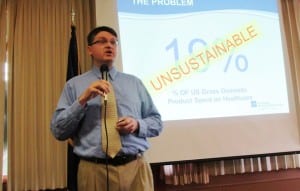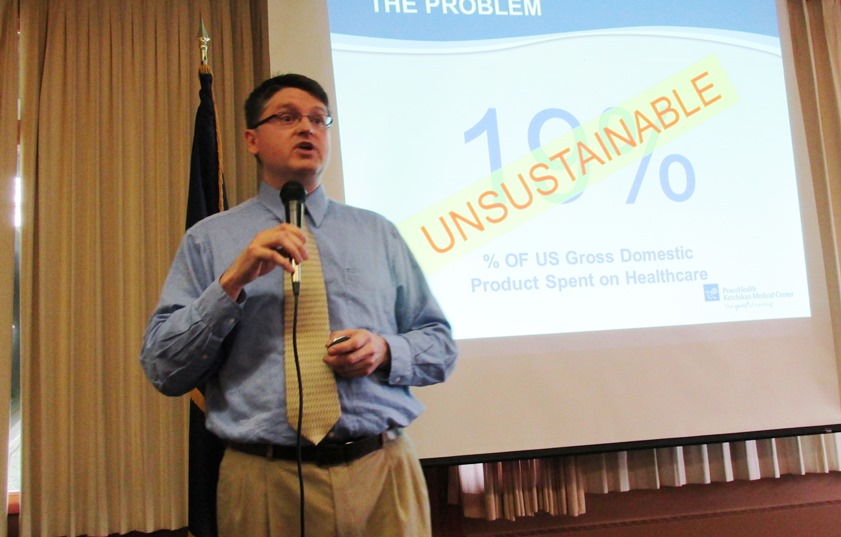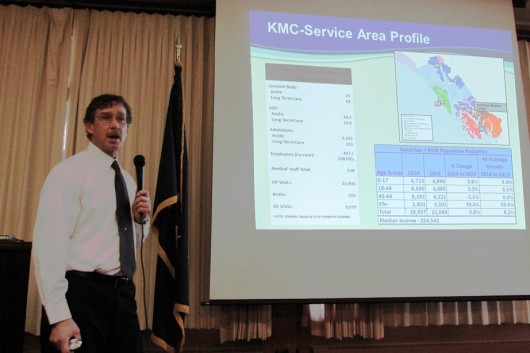PeaceHealth Ketchikan Medical Center officials want more Ketchikan residents to use the local hospital for necessary procedures, but at the same time, they hope to reduce the overall need for medical intervention.
It’s a bit of a paradox that health providers everywhere face: How to improve general health among patients, but still stay financially strong. Two Ketchikan Medical Center officials talked about that and other healthcare topics during this week’s Ketchikan Chamber of Commerce lunch.
Matt Eisenhower is executive director of the PeaceHealth Ketchikan Medical Center Foundation, and oversees community health development. He’s a numbers guy, and so he went through a few numbers at the start of his presentation. The first number he gave was 19.
“Anyone want to take a stab at what that number might be? This is the percentage of the gross domestic product that is spent on health care,” he said.
In real money, that’s about $3.8 trillion dollars. And when that’s averaged out to the amount spent per citizen, health care in the United States costs twice the average of other developed nations.

Matt Eisenhower is executive director of the PeaceHealth Ketchikan Medical Center Foundation, and oversees community health development.
The need nationwide is growing, too. Eisenhower said that as the Baby Boomers enter retirement, 10,000 new people sign up for Medicare every day. All those numbers signal one thing: Change.
Eisenhower said healthcare providers need to change, too. At PeaceHealth, he said, patients are the focus, and changes should benefit those patients.
“Our whole facility design is changing to focus on some of the health care changes that we’re seeing, and we want to focus on keeping healthy people healthy,” he said.
Part of that is more outpatient care, programs to help people manage chronic disease and care coordinators to help patients get their health needs properly met. Eisenhower said the numbers show that the programs are making a difference.
“For instance, we’ve had a 15-22 percent reduction in payments to us because they’re not using our inpatient services as much,” he said. “As business owners, you’re probably scratching your heads thinking, ‘Why would you do that?’ That’s something we’re struggling with. We’re actively trying to reduce costs to patients, because it’s the right thing to do. But that means that operationally, we’re going to have to cinch our belts and find better ways to do things.”
For example: cut administrative positions.
Ken Tonjes is the chief administrative officer of Ketchikan Medical Center. That’s a newish position created when the jobs of chief executive officer and chief financial officer were combined. Tonjes also spoke during the Chamber presentation, and said it’s challenging to do both those jobs, and he’s probably not doing either quite as well as when they were separate positions.
“But, that’s again, what we’re trying to do is we’re trying to provide as many resources to the direct patient care as we possibly can,” he said. “And frankly, we saw this as an opportunity. It makes my life a little more difficult, but it’s a tradeoff we’re willing to do.”
Tonjes also talked about some of the ways PeaceHealth is adapting to a changing healthcare culture, including collaboration for behavioral health services, visiting clinics for services that are important, but don’t have enough volume to offer all the time, and telemedicine.
“So we’re always looking at opportunities to bring a larger breadth of services in here,” he said. “But remember, they have to be sustainable. The last thing we want is to start a service, but then for whatever reason: Availability, access or dollars, we’re not able to continue to do that.”
PeaceHealth is a nonprofit Catholic health care provider that operates 10 hospitals in the Pacific Northwest.
Tonjes said “nonprofit” doesn’t mean that they don’t try to make a profit – it just means that profits are invested back into their health care system. He added that Ketchikan’s hospital has a strong balance sheet, with reserves to weather financial storms.







